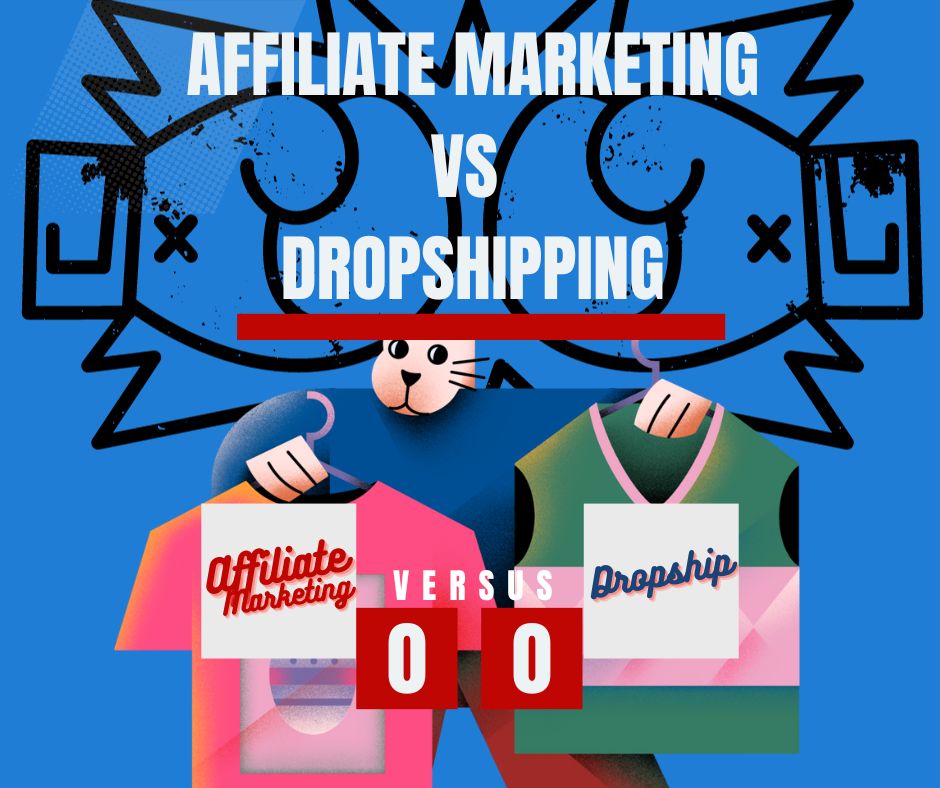Table of Contents
Toggle
Table of Contents
ToggleI. Introduction
Among the myriad of online business models, Affiliate Marketing and Dropshipping stand out as prominent contenders. These models, though distinct, offer a gateway to financial independence with relatively low entry barriers. However, the journey towards a successful online venture is often laden with decisions, each capable of steering the business towards prosperity or adversity. Hence, a thorough understanding of these models is imperative for aspiring entrepreneurs. This article endeavors to elucidate the core principles of Affiliate Marketing and Dropshipping, aiming to equip the reader with the essential knowledge required to make informed decisions in their entrepreneurial voyage.
Affiliate Marketing and Dropshipping are often perceived as lucrative and accessible avenues to delve into the online business realm. The allure of financial independence, coupled with the convenience of operating from anywhere, makes these models highly appealing. However, despite their popularity, a veil of ambiguity often shrouds the operational nuances of Affiliate Marketing and Dropshipping. This lack of clarity could potentially lead to misguided decisions, thereby affecting the success and sustainability of one’s online venture.
Each model embodies a unique operational framework and necessitates a different set of skills and resources. Affiliate Marketing, at its core, revolves around promoting products or services of other businesses and earning a commission for every sale made through one’s referral. On the flip side, Dropshipping entails selling products to customers without holding any inventory, where the sales order is forwarded to a third-party supplier who fulfills the order on your behalf.
II. What is Affiliate Marketing?
A. Definition and Basics
Affiliate marketing is a digital advertising model where companies collaborate with individuals or other companies, known as affiliates, to drive traffic, leads, or sales to their products or services. In this arrangement, affiliates earn a commission for the actions generated through their marketing efforts. This model is a win-win as it provides companies with a cost-effective way to promote their offerings while enabling affiliates to earn income from their marketing skills. We have covered the topic of what is affiliate marketing, and if you would like to find out more, click here
B. How Affiliate Marketing Works
The process begins with you, an affiliate joining a company’s affiliate program or company. Upon joining, the affiliate receives a unique referral link or code, which is used to track the traffic or sales they generate. Affiliates promote the company’s products or services through various channels such as blogs, social media, or email marketing, using the provided referral link. When individuals click on the referral link and take a specified action (like making a purchase or signing up), the affiliate earns a commission. The commission rate is predetermined and can vary widely, depending on the company and the nature of the products or services being promoted. Through affiliate marketing, companies can extend their reach and affiliates can build a source of income, making it a popular choice in the digital marketing realm.
III. What is Dropshipping?
A. Definition and Basics
Dropshipping is a retail fulfillment method where sellers list products on their website without keeping inventory. When an order is placed, the seller purchases the product from a third-party supplier who then ships it directly to the customer. Essentially, the seller which is yourself, acts as a middleman between the supplier and the buyer. This model allows individuals to start a business without the need to lease warehouse space, manage supply chains, or handle inventory, making it a relatively low-barrier entry to the e-commerce world.
B. How Dropshipping Works
The dropshipping process is fundamentally a relationship between a customer-facing store and a supplier. Once a customer places an order on the store, the order details are forwarded to the supplier. The supplier then fulfills the order, shipping the product directly to the customer. There are various ways to adopt a dropshipping business model. One common approach is to connect with wholesale suppliers through online databases like AliExpress, SaleHoo, or Worldwide Brands. Alternatively, store owners can use apps like DSers, which connects the store to thousands of suppliers, automating most of the dropshipping process. This way, once a customer buys a product, the store owner only needs to confirm the details and process the order in the app, and the product is shipped directly from the supplier to the customer. This model allows for a wide selection of products to be sold, easy scaling of business operations, and requires less upfront capital, making it an attractive model for aspiring online entrepreneurs.
IV. Comparative Analysis: Affiliate Marketing vs Dropshipping
A. Startup Costs
Both affiliate marketing and dropshipping are attractive for their low startup costs. Affiliate marketing generally requires minimal investment, often just a website or a social media platform to start promoting products. Dropshipping also boasts low startup costs, with the primary expense being the creation and hosting of an online store. You can always go for a free version but be aware that there’s so many things that you need to do on your own. Dropshipping may incur additional costs for purchasing products upfront, albeit only after a customer has placed an order.
B. Potential Earnings
The earning potential in both models can be substantial but varies based on several factors. In affiliate marketing, earnings are commission-based, dependent on the product’s price and the agreed commission rate. Dropshipping earnings are derived from the difference between the selling price and the wholesale price. Typically, dropshippers have the flexibility to set their selling prices, which can lead to higher profit margins compared to affiliate marketing, where commission rates are fixed.
C. Operational Complexities
Operational complexities in dropshipping include managing customer service, handling returns, and ensuring timely delivery by suppliers. In contrast, affiliate marketers are free from these operational hassles as they merely redirect customers to the merchant. However, they may face restrictions on promotional activities imposed by the affiliate programs, which can hinder marketing efforts.
D. Scalability
Dropshipping offers better scalability as entrepreneurs can expand their product range and grow their customer base over time. They also have the opportunity to brand their business, fostering customer loyalty. On the other hand, affiliate marketing lacks this level of scalability as affiliates do not have control over the products or the customer experience, making it challenging to build a long-term customer base. Saying that, if however you have a huge email listing for a specific niche and market your own product or service including affiliate sales, this will reach greater heights.
In conclusion, while both models offer lucrative opportunities, dropshipping provides a better platform for entrepreneurs looking to build and grow a long-term business. The control over pricing, fewer promotional restrictions, and the potential to build a loyal customer base are significant advantages that dropshipping holds over affiliate marketing. Some may say otherwise but it depends on where they are at for the business.
V. Making the Right Choice: Factors to Consider
A. Your Skill Set
The path you choose between affiliate marketing and dropshipping should resonate with your skills. Both needs a little bit of promotional skills like digital marketing however affiliate marketing have sort of the help that you need with their landing page ready and sales scripts ready. It requires less technical know-how and more of marketing skills. On the other hand, if you have a good grasp of e-commerce platforms and customer service, dropshipping might be the route to take. It demands a more hands-on approach in managing an online store, dealing with suppliers, and ensuring customer satisfaction.
B. Available Resources
Evaluate the resources at your disposal. Affiliate marketing demands less financial input; a functional website or a strong social media presence might be all you need to kick start your affiliate marketing journey. Conversely, dropshipping may require a bit more capital to set up an online store, although it’s still relatively low compared to traditional retail. Besides financial resources, consider the time you can dedicate, the support you have, and the tools and technology you can access to streamline operations.
C. Long-term Goals
Reflect on your long-term aspirations. If you’re looking to build a brand and have a more direct relationship with your customers, dropshipping allows for that. It provides a platform to grow a loyal customer base and expand product offerings over time. Affiliate marketing, while less demanding, may offer a more passive income stream without the complexities of managing a store. However, it may not provide the same level of brand building and customer engagement as dropshipping.
In conclusion, the decision between affiliate marketing and dropshipping hinges on a blend of your skill set, the resources you can muster, and the long-term vision you harbour for your online venture. Each model has its merits and could be a stepping stone to a lucrative online business, provided it aligns well with your circumstances and aspirations.
VI. Conclusion
A. Summary of Key Takeaways
The journey through the realms of Affiliate Marketing and Dropshipping unveils two distinct paths towards e-commerce success. While affiliate marketing offers a low-barrier entry, focusing on promoting products for commissions, dropshipping immerses you in a more hands-on retail experience, allowing for brand building and direct customer engagement. The choice hinges on various factors including your skill set, available resources, and long-term business aspirations.
B. Encouragement to Choose the Right Model
Embarking on an online business venture is an exhilarating endeavor that demands a well-informed decision. Both Affiliate Marketing and Dropshipping present lucrative opportunities, each with its unique set of advantages and challenges. Your success in either model will be a testament to your adaptability, perseverance, and the strategic alignment of your choice with your inherent strengths and long-term business goals. As you stand at the crossroads of Affiliate Marketing and Dropshipping, may your choice propel you towards the pinnacle of e-commerce success.
FAQs:
Which business model is easier to start for beginners?
Affiliate Marketing: Generally easier for beginners as it requires less upfront investment and operational oversight. You primarily need to focus on promoting products through various channels like blogs, social media, or email marketing.
Dropshipping: Requires a bit more technical knowledge and operational management. You’ll need to set up an online store, manage customer service, and coordinate with suppliers.
How much capital do I need to start in affiliate marketing or dropshipping?
Affiliate Marketing: Minimal to no capital is required to start. You might want to have a website or a social media platform to promote products, which could incur some costs.
Dropshipping: Requires some capital to set up an online store, purchase a domain name, and possibly some initial marketing to drive traffic to your store. However, it’s still relatively low compared to traditional retail. But there is a zero capital required as well like we said, however it will take a little bit more effort on your end to set it up.
Can I do both affiliate marketing and dropshipping at the same time?
Yes, you can do both affiliate marketing and dropshipping at the same time. For instance, you could have a blog where you promote products as an affiliate, and also have an online store for dropshipping. This way, you diversify your income streams.
Which business model has a better income potential?
Affiliate Marketing: The income potential can be substantial but may take some time to build as it relies on building a good traffic base and having high-converting affiliate offers.
Dropshipping: Potentially has higher income potential since you set your own prices and profit margins. However, it may require more effort in customer service and supplier management.
Are there any tools or platforms that can help me get started with either business model?
Affiliate Marketing: Platforms like ShareASale, ClickBank, or Amazon Associates are great to find affiliate programs. Tools like Pretty Links can help manage and track your affiliate links.
Dropshipping: Shopify is a popular platform for setting up a dropshipping store. Oberlo or AliExpress are platforms that can connect you with suppliers. Additionally, tools like SaleHoo can help in finding and vetting suppliers.




